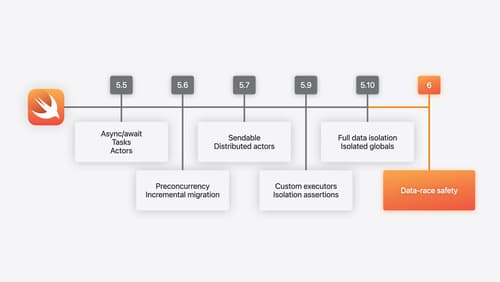how do I resolve swift 6 language errors
Asked on 2024-08-05
1 search
To resolve Swift 6 language errors, you can follow several steps and utilize the new features and improvements introduced in Swift 6. Here are some key points and resources from WWDC 2024 sessions that can help you:
-
Type Throws: Swift 6 introduces type throws, which allow you to specify the error type along with the
throwskeyword. This eliminates type erasure and makes error handling more precise. You can learn more about this in the session What’s new in Swift. -
Concurrency and Data-Race Safety: Swift 6 brings full data isolation enforcement and compile-time data race safety. This means the compiler will diagnose concurrent access to memory, helping you fix data race issues. You can adopt Swift 6 language mode incrementally, module by module. For more details, refer to the session Migrate your app to Swift 6.
-
Compiler Diagnostics: The new Swift 6 compiler diagnostics will guide you towards places in your code that need fixing, acting like a pair programmer. This helps in structuring your migration process. More information can be found in the session Migrate your app to Swift 6.
-
Error Handling Philosophy: Swift's error handling model is designed to make it easy to report and handle errors gracefully. It differentiates between recoverable errors and programmer mistakes. For a deeper understanding, check out the session A Swift Tour: Explore Swift’s features and design.
-
Adopting Swift 6 Language Mode: You can enable the Swift 6 language mode to take advantage of new features and improvements. This mode is opt-in and can be adopted when you are ready. For a practical guide on enabling this mode, see the session Migrate your app to Swift 6.
Relevant Sessions:
By following these guidelines and utilizing the resources provided in these sessions, you should be able to resolve Swift 6 language errors effectively.

A Swift Tour: Explore Swift’s features and design
Learn the essential features and design philosophy of the Swift programming language. We’ll explore how to model data, handle errors, use protocols, write concurrent code, and more while building up a Swift package that has a library, an HTTP server, and a command line client. Whether you’re just beginning your Swift journey or have been with us from the start, this talk will help you get the most out of the language.

Platforms State of the Union
Discover the newest advancements on Apple platforms.

What’s new in Swift
Join us for an update on Swift. We’ll briefly go through a history of Swift over the past decade, and show you how the community has grown through workgroups, expanded the package ecosystem, and increased platform support. We’ll introduce you to a new language mode that achieves data-race safety by default, and a language subset that lets you run Swift on highly constrained systems. We’ll also explore some language updates including noncopyable types, typed throws, and improved C++ interoperability.
